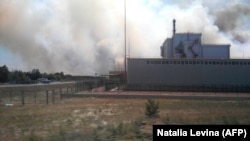Scientists have been concerned for decades about potentially catastrophic wildfires inside the exclusion zone around the defunct Chernobyl nuclear power plant in Ukraine -- the site in 1986 of the world's worst nuclear accident.
That's because trees and brush in the zone have absorbed radioactive particles that can be released into the air by the smoke of a wildfire.
Not surprisingly, some experts are skeptical about Ukrainian Prime Minister Volodymyr Hroysman's claim on Facebook that "there's no need to worry" about a June 5 blaze that raced through the so-called Red Forest -- one of the most contaminated patches of forest near Chernobyl.
'Don't Worry'
"Radiation levels are safe" in Kyiv and at Chernobyl itself, Hroysman said, shortly after administrators of Chernobyl's exclusion zone announced that radiation levels had not risen inside the zone or in adjoining areas.
Nuclear-safety experts say the real risk posed by Chernobyl wildfires is the "resuspension" of existing contaminants into the air and the dispersal of radiation to nearby areas by the wind.
With a big enough wildfire, scientists have concluded, radioactive contamination could be spread as far from Chernobyl as Britain.
For the 130 firefighters working to extinguish the latest blaze just 10 kilometers from the ruins of the Chernobyl nuclear plant, experts say the health risks from exposure to radioactive smoke are significant.
Recurring Wildfires
Wildfires have become a regular occurrence in the exclusion zone in recent years.
That's because the area has not been farmed or controlled by human management for so long that brush and young trees have grown out of control -- creating a ready fuel supply for blazes.
The worst outbreak so far was in April 2015 when a wildfire raged for four days within 20 kilometers of Chernobyl and consumed some 400 hectares of brush and trees -- sending radioactive smoke hundreds of meters into the air.
Ukrainian nuclear inspectors did measure an increase in the radioactive element Cesium-137 during the 2015 blaze -- reaching a level about 10 times "above the norm."
An international study in 2014 concluded that the release of Cesium-137 from "hypothetical" wildfires in Chernobyl's forests would be classified as "high" on the International Nuclear Events Scale (INES) -- a tool used to communicate the safety significance of nuclear and radiological events to the public.
Other studies have shown that radioactive smoke landing on crops even 150 kilometers from a fire can concentrate radiation in food to the point that it is harmful to eat.
Compared to the 400 hectares of forest that burned in 2015, the latest blaze is small -- involving only about 12 hectares of forest.
But the fire ravaged Chernobyl's highly contaminated Red Forest -- which got its moniker because all the pine trees there died from radiation in 1986, turning the landscape ginger-brown.
Dead "Red Forest"
John Large, an independent nuclear safety expert in Britain who has closely followed the aftermath of the Chernobyl disaster, describes the Red Forest as one of the places that suffered the highest concentration of radioactive fallout from the initial explosion and fire at the nuclear plant in 1986.
"When the radioactivity was being released in one phase of the disaster, that's where it came down...the initial stages where the heavier elements came down," he explained.
"Remember that the Soviets' immediate response to Chernobyl was to try to cover it up, literally, by burying the waste in ad hoc and expedient measures," he said.
Those hasty, initial steps in 1986 did not prevent the radioactivity from becoming concentrated in later forest growth, Large said.
"Nuclear regulatory authorities, dare I say particularly in Eastern Europe, tend to be very guarded about what they say, the amount of information that is released, the availability and the transparency and particularly the accountancy of the actions taken," Large told RFE/RL. "Information is not particularly forthcoming, so it's difficult to assess."










